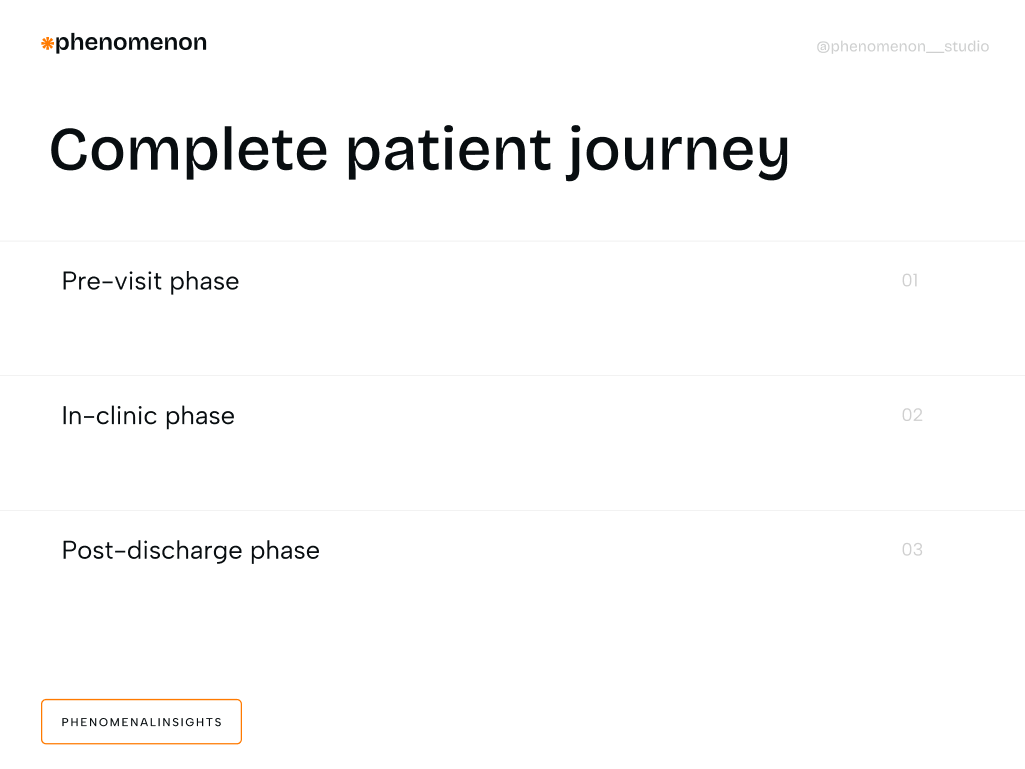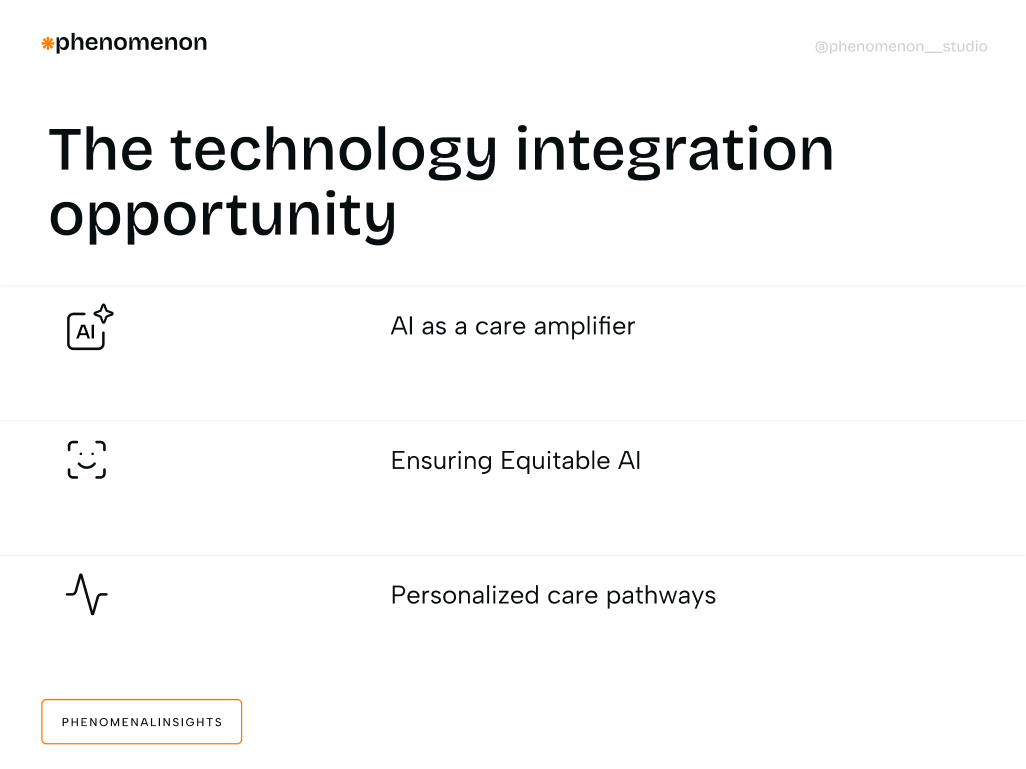Discover how strategic healthcare design reduces patient anxiety, streamlines operations, and improves outcomes. Partner with experts who deliver results.
Healthcare organizations face mounting pressure from rising costs, patient expectations, and workforce burnout. The traditional approach of treating symptoms isn’t working. What if the solution lies in redesigning the entire patient experience?
At Phenomenon Studio, a company specializing in healthcare web design, we’ve seen firsthand how strategic design transforms healthcare delivery. As a medical web design company, our expertise and credibility help reduce patient anxiety and streamline operations, creating measurable improvements across every touchpoint of care.
This comprehensive guide explores how design thinking can revolutionize your healthcare organization, turning frustrating patient journeys into seamless, empathetic experiences that drive better outcomes and operational efficiency.
The Hidden Cost of Poor Patient Experience
Most healthcare organizations unknowingly hemorrhage resources through poor design choices. Consider these common scenarios:
The Digital Barrier: Patients spend 20 minutes on hold trying to schedule appointments, then abandon the call entirely. Your staff waste hours managing scheduling conflicts and no-shows.
The Anxiety Amplifier: Confusing wayfinding systems leave patients lost and stressed before they even reach their appointment. Late arrivals disrupt your entire schedule.
The Communication Gap: Discharge instructions written in medical jargon lead to medication errors and readmissions. Your organization faces penalties and reduced reimbursements.
These aren’t isolated incidents. They represent systematic design failures that compound across the patient journey, creating a cascade of inefficiencies that impact everyone involved. Poor design choices can also lead to lower conversion rates, resulting in fewer patients booking appointments or engaging with your organization online.
Research shows that communication failures contribute to over 7,000 medical malpractice lawsuits annually. Poor patient experience directly correlates with decreased trust, longer hospital stays, and increased operational costs.
Understanding the Complete Patient Journey
Effective healthcare design starts with mapping the entire patient experience. This journey encompasses three critical phases:

Pre-Visit Phase
The experience begins when patients first recognize symptoms and seek care. This includes:
- Initial symptom research and provider selection
- Appointment scheduling and pre-registration, with an emphasis on online appointment scheduling to improve convenience and efficiency for patients by allowing real-time self-booking and seamless integration with existing healthcare software
- Intake form completion and preparation
In-Clinic Phase
The physical healthcare encounter involves:
- Facility navigation and check-in processes
- Waiting room experience and staff interactions
- Clinical consultations and treatment delivery
- Digital kiosks with interactive maps and mobile apps, which should be designed to function seamlessly across different screen sizes to ensure accessibility for all users
Post-Discharge Phase
Recovery extends far beyond the clinical setting:
- Discharge planning and instruction clarity
- Medication adherence and follow-up care
- Long-term recovery support and monitoring, including the use of patient portals to facilitate ongoing communication and access to resources during recovery
Each phase influences the next. A frustrating scheduling experience creates anxiety that amplifies waiting room stress, which then impacts the quality of patient-provider communication. This interconnected nature requires a holistic design approach that addresses the entire continuum of care.
Transforming the Digital Front Door
Your organization’s digital presence serves as the first impression for most patients. A professional medical website is the foundation of a strong digital front door, ensuring your healthcare organization is accessible, compliant, and patient-focused. Poor digital design creates immediate barriers to care access.
Streamlined Scheduling Solutions
Replace phone-based scheduling with real-time online booking systems. Patients can view available appointments, select convenient times, and receive automated confirmations. This reduces administrative workload while improving patient satisfaction.
Dedicated landing pages can be used to streamline the appointment booking process and improve patient conversion by guiding visitors directly to tailored scheduling options.
Implement dynamic scheduling that integrates with your calendar systems, preventing double-bookings and scheduling conflicts. Virtual waitlists can automatically fill last-minute openings, maximizing efficiency.
Digital Intake Optimization
Design HIPAA-compliant digital forms that patients complete at home. Pre-populate known information to minimize repetitive data entry. This saves patients time while improving data accuracy and reducing staff administrative burden.
Advanced intake systems sync directly with Electronic Health Record (EHR) platforms, eliminating manual data entry and reducing errors by up to 40%.
It is important to have a content management system that allows staff to easily update website content, ensuring that intake forms and patient information remain current and accurate.
Addressing Digital Equity
Ensure your digital solutions don’t create new barriers for underserved populations. Implement multi-modal access options, including phone-based alternatives to digital tools. Provide materials in multiple languages and design interfaces with accessibility features for users with disabilities, such as a prominently placed search bar to help users—especially those with limited digital literacy—quickly find the information they need.
Key Principles of Healthcare Websites
A well-designed healthcare website is the cornerstone of a healthcare organization’s digital presence. To attract and retain more patients, healthcare websites must prioritize a user-friendly interface that guides visitors effortlessly to the information and services they need. Easy navigation, clear calls to action, and a logical site structure are crucial for helping users find treatment options, schedule appointments, or access resources without frustration.
Security is another essential principle—patients trust healthcare organizations with sensitive information, so robust security measures and HIPAA compliance are non-negotiable. Optimizing your healthcare website for search engines ensures your services appear in search results when potential patients are looking for care, expanding your reach and bringing in more patients.
Incorporating multimedia elements such as videos, infographics, and interactive tools can make complex medical information more accessible and engaging. These features not only improve user engagement but also help guide visitors through their healthcare journey. By focusing on these key principles, healthcare organizations can create websites that function flawlessly, build trust, and convert visitors into loyal patients.
Creating a Strong Healthcare Brand
A strong healthcare brand is essential for building trust and credibility with patients in a competitive landscape. Your healthcare brand should clearly communicate your organization’s values, mission, and the unique services you provide. Consistency across all platforms—your website, social media, and patient communications—reinforces your identity and helps patients recognize and remember your organization.
Key elements of a successful healthcare brand include a clear and concise message that resonates with your target audience, a distinctive visual identity that sets you apart, and a consistent tone and voice that reflects your organization’s personality. By investing in these foundational aspects, healthcare organizations can create a brand that not only attracts more patients but also builds lasting trust and loyalty. Ultimately, a strong healthcare brand is essential for establishing your organization as a leader in quality care and patient experience.
Optimizing Clinical Interactions
The patient-provider encounter forms the foundation of quality healthcare. Adopting best practices in clinical interaction design is essential for healthcare providers and practices to ensure effective communication and optimal patient care. Design solutions that enhance rather than hinder these critical interactions.
Technology as an Enabler
Ensure your EHR systems integrate seamlessly with clinical workflows. Healthcare software plays a crucial role in streamlining these workflows and improving provider efficiency by enabling providers to access, update, and review patient records within a single interface, eliminating the need to switch between multiple systems.
Design interfaces that reduce “note bloat” and administrative burden, allowing providers to focus on patient care rather than documentation requirements.
Communication Design
Train staff to use plain language instead of medical jargon. Implement structured communication protocols like the RELATE method that promote active listening and empathy.
Provide patients with decision-making tools and educational resources that support shared decision-making processes. Skilled designers play a key role in developing clear, user-friendly educational resources that help patients better understand their options.
Supporting Post-Discharge Recovery
The transition from clinical care to home recovery represents a high-risk period for both patients and healthcare organizations. Design comprehensive support systems that ensure continuity of care. It is essential to expand post-discharge support systems to address the full spectrum of patient needs during recovery.
Clear Discharge Planning
Create After Hospital Care Plans (AHCP) that use plain language and visual design elements. Include:
- Personalized contact information for key providers
- Color-coordinated calendars for appointments and medications
- Clear instructions for emergency situations
Well-developed care plans are essential for ensuring patient understanding and adherence.
Implement the “teach-back” method where patients explain their care plan in their own words, ensuring comprehension before discharge.
Remote Monitoring Solutions
Design intuitive remote patient monitoring (RPM) platforms that enable continuous care outside clinical settings. Strong development capabilities are essential for building robust and scalable remote monitoring solutions that integrate directly with EHR platforms while remaining simple for patients to use.
Studies show RPM programs can reduce hospital readmissions by up to 75% for high-risk patients while achieving high patient satisfaction rates.
Community Connection
Design systems that connect patients with community resources and social support networks. Directing patients to reputable health-related sites, such as healthcare provider sites, clinical trial sites, and informational platforms, can offer additional support and information tailored to their needs. Recovery extends beyond medical adherence to encompass emotional well-being and lifestyle changes.
The Technology Integration Opportunity
Artificial intelligence and machine learning present unprecedented opportunities to enhance patient care through design-led implementation. Integrated technology solutions must be designed to ensure everything functions flawlessly across platforms and devices, providing a seamless experience for both patients and healthcare providers.

AI as a Care Amplifier
Design AI solutions that augment rather than replace human care. AI scribes can automate note transcription, reducing administrative burden on providers. Predictive analytics can identify at-risk patients before crises occur, enabling proactive intervention. These AI tools can be tailored to the specific needs of each healthcare practice, supporting private practice management and helping practices attract and serve patients more effectively.
Ensuring Equitable AI
Apply equity-focused design principles to AI development. Ensure training data represents diverse patient populations to prevent algorithmic bias. Design AI interfaces that are accessible across different literacy levels and cultural contexts. Involve healthcare clients throughout the development process to ensure AI solutions address their specific needs and challenges.
Personalized Care Pathways
Use AI to create individualized care experiences based on patient preferences, medical history, and social determinants of health. Collaborate closely with clients to design personalized care pathways that address their unique needs and goals. This moves beyond one-size-fits-all approaches to truly personalized care delivery.
Measuring Design Success
Effective healthcare design requires comprehensive measurement strategies that capture both quantitative metrics and qualitative experiences. Preparing the client to provide necessary data and timely feedback is essential for accurately measuring and evaluating the success of the design.
Operational Metrics
Track traditional healthcare indicators like:
- Patient satisfaction scores
- Hospital readmission rates
- Length of stay measurements
- Staff productivity metrics
- Medical error rates
Human-Centered Indicators
Measure the emotional and experiential aspects of care:
- Patient stress and anxiety levels
- Staff burnout and job satisfaction
- Care team collaboration effectiveness
- Patient comprehension and engagement
Implementation Approach
Start with small, manageable projects that demonstrate design impact. Create multidisciplinary teams that include patients, providers, and staff as co-creators in the design process.
Use rapid prototyping methods to test solutions quickly and gather real-time feedback before investing in large-scale implementations.
Understanding Design Cost
Understanding the design cost of a healthcare website is crucial for effective planning and budgeting. The total cost can vary significantly based on the complexity of the project, the experience and reputation of the design agency, and the advanced technologies required to meet your organization’s needs. A reputable design agency will provide a transparent and detailed estimate, outlining all costs involved—from initial development and testing to launch and ongoing support.
It’s important for healthcare organizations to consider not just the upfront investment, but also the long-term costs of maintaining and updating the website to ensure it continues to function flawlessly and remains secure. Factoring in these ongoing support costs helps organizations avoid unexpected expenses and ensures the website remains a valuable asset. By fully understanding the design cost, healthcare organizations can make informed decisions and create a website that delivers quality, security, and value within their budget.
Working with a Design Agency
Partnering with a design agency offers healthcare organizations access to extensive experience and specialized expertise in healthcare website design. A skilled agency will understand the unique challenges of the healthcare industry and bring a team equipped with advanced technologies and a dedicated project manager to guide your project from start to finish.
When selecting a design agency, look for a proven track record in delivering high-quality healthcare websites, as well as a clear and collaborative design process. The agency should outline timelines, milestones, and costs upfront, ensuring transparency and alignment with your organization’s goals. A dedicated project manager acts as your main point of contact, streamlining communication and keeping the project on track.
By working with a reputable design agency, healthcare organizations can create websites that not only engage and convert visitors into patients but also establish a strong, trustworthy online presence. This partnership ensures your website meets the highest standards of quality, security, and performance—helping your organization stand out and succeed in a digital-first healthcare landscape.
Your Next Steps in Healthcare Design
Transforming your healthcare organization through design requires strategic planning and committed leadership. Here’s how to begin:
Step 1: Conduct comprehensive patient journey mapping to identify current pain points and opportunities.
Step 2: Form multidisciplinary design teams that include diverse stakeholders from across your organization.
Step 3: Start with pilot projects in high-impact areas like scheduling or discharge planning.
Step 4: Measure both operational outcomes and human experiences to demonstrate design value.
Step 5: Scale successful interventions across your organization while maintaining focus on continuous improvement.
Partner with Design Experts
Healthcare design transformation requires specialized expertise that combines clinical understanding with design methodology. At Phenomenon Studio, we help healthcare organizations create patient-centered experiences that drive measurable improvements in outcomes, satisfaction, and operational efficiency.
Our team understands the unique challenges facing healthcare providers. We’ve helped organizations reduce patient anxiety, streamline operations, and create healing environments that support both patients and staff.
Ready to transform your patient experience? Contact Phenomenon Studio today to discuss how strategic design can solve your organization’s most pressing challenges and create sustainable competitive advantages in an evolving healthcare landscape.
The future of healthcare depends on organizations that recognize design as a strategic discipline with direct impact on care quality and organizational success. Make design your competitive advantage.













